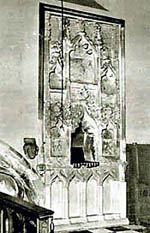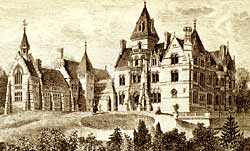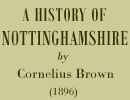< Previous | Contents | Next >
Arnold and Bestwood Park

St Mary's church, Arnold, in 1913. The most important part of the church is the mid-14th century chancel.
Arnold and Bestwood, now busy centres of industry, in equally close proximity to Nottingham, were once within the bounds of Sherwood Forest; but the merry horn of the hunter sounding through the woodland glades as he pursued his quarry has given place to the shriek of the locomotive whistle and the rattle of the hosiery frames. The two parishes have become suburbs of the great town but notwithstanding all the changes that have taken place, there is still the ancient parish church of Arnold, with its architectural antiquities, to link us with the past. At the time when this was built, in the Early English style about 1270, the family of Arnehall, or Arnold, had risen into considerable prominence, for in 1278 Ralph de Arnehall was created a knight by Edward I.
Other owners of property at Arnold in early days were the Earls of Hereford, Margaret, wife of Sir Thomas Rempstone, Sir Nicholas de Strelley, John Foljambe, and Ralph, Lord Cromwell, the famous Treasurer to Henry VI. In the time of Edward VI. the Duke of Clarence was lord of the manor, which then passed to the family of Hastings.

Mid-14th century Easter Sepulchre.
The chancel of the church was erected in the fourteenth century, when the Earls of Hereford were in possession of the property. In it are the remains of an Easter sepulchre—one of the few stone constructions of the kind to be found in the country. There are no figures or ornaments left here, but an account dated July 4, 1470, containing details of materials for making a similar construction at St. Mary Redcliffe, will give an idea of what was generally represented: ‘Item. Hell made of timber, and ironwork thereto, with the Divels to the number of 13; item, 4 armed knights, keeping the sepulchre with their weapons in their hands, that is to say two axes, and two spears with two paves.’ There are also in the church the founder’s tomb, a splendid triple sedilia and a double piscina.
Adjoining the village of Arnold is Bestwood Park, the beautiful residence of the Duke of St. Albans. In an inquisition taken at St. John’s House at Nottingham, in 1281, before Geoffrey Langley, Justice of the Forest, it is described as ‘a park of our Lord the King, wherein no man commons.’ The Plantagenets were fond of resorting here to enjoy the pleasures of the chase, and it was at Bestwood that Richard III. heard of the approach of his rival, Henry Tudor. Thoroton speaks of the park as having ‘a very fair lodge in it,’ which had been in the possession of three Earls of Rutland, and before that of Thomas Markham, one of Queen Elizabeth’s courtiers, and of Sir John Byron—a favourite of King Henry VIII. In the historian’s time it was in lease to William Lord Willoughby of Parham.
At the period when the keepership of Bestwood passed to Roger, Earl of Rutland, the park abounded with deer, for, writing to the Earl in 1607, John Woods and Lancelot Rolleston say: ‘We find that there are in the park at least three hundred fallow-deer, and four-and-twenty red deer.’ A subsequent account of the property shows that in 1650 the hall was built of wood, lime, and plaster, and covered with slate and tile, and contained thirty-eight rooms. The park was enclosed, and contained about 3,000 acres, of which 100 acres were tilled, and the rest was in pasture, in the occupation of William Willoughby, Esq.

Bestwood Lodge in the late 19th century.
In 1683 Charles II., by letters patent, granted Bestwood to Charles Beauclerk, first Duke of St. Albans. This noble family has done much to improve it and make it worthy to rank as one of the stately homes of England. In 1885 Bestwood Lodge was completed, under the direction of the present Duke, and is a fine specimen of domestic architecture in the style of the fifteenth century. Among royal visitors entertained by his Grace were the Prince and Princess of Wales on the occasion of the opening of Nottingham Castle Museum in 1878, and the late Duke of Albany, who opened the University College. In the park is erected a beautiful little church, in which lie the remains of the late Duchess, to whom there is a memorial, and a marble medallion carved by the Princess Louise. The Duke is Lord-Lieutenant of Nottinghamshire, and takes a lively interest in philanthropic and deserving institutions, both in the county town and the district surrounding it.
